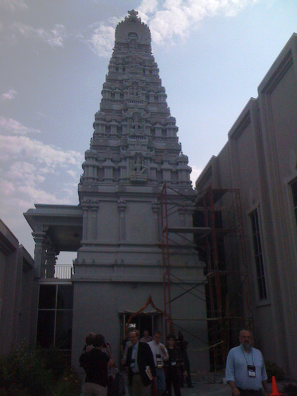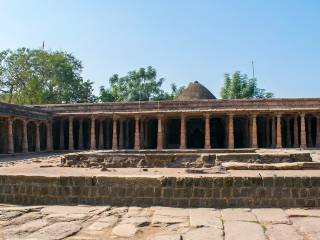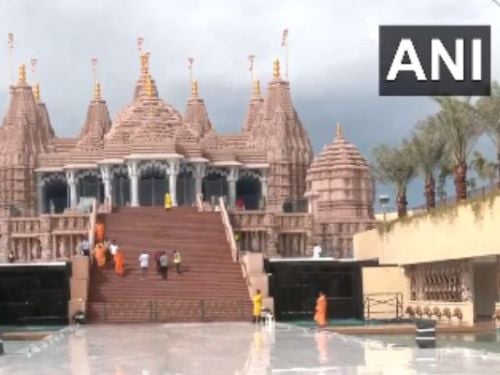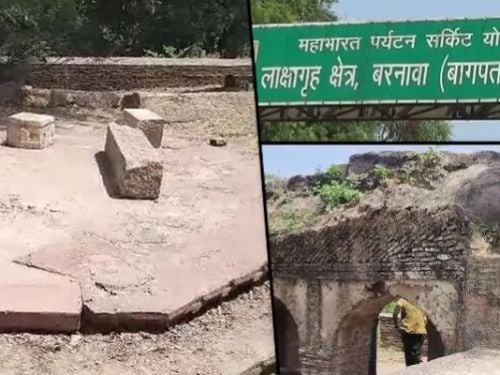On Saturday afternoon the reporters attending the annual convention of the Religion Newswriters Association boarded a pair of buses from downtown Minneapolis out to Maple Grove, a small community in the northwest corner of greater Minneapolis-St. Paul where, on 80 acres surrounded by farmland, the region’s Hindu community is completing work on what they claim is the largest Hindu temple in the U.S.
 Largest Hindu Temple in U.S. |
The Hindu Temple of Minnesota is quite a sight a massive boxy structure surrounding an ornate gray tower with a wedding cake top featuring layer upon layer of sculptured lotuses and icons. Inside there are lots of conventional communal spaces a library, meeting rooms, a cafeteria and an auditorium, and one striking room, lit by a series of skylights, in which 21 shrines ring a large open floor area. This temple is unlike anything you would see in India – there, temples are typically centered on a single deity, but because this is the U.S., where the Hindu community hails from all over India as well as the Hindu diaspora, the temple opted for a variety of shrines to meet the needs and devotional practices of a diverse group of worshipers. When we visited, there were families and individuals bringing offerings of food and money to various shrines, there were worshipers praying silently, touching their foreheads to the floor or lying fully prostrate for a while, there was a large group praying collectively as a priest performed a ritual at the shrine of Lord Vishnu, and there was a group of adults and children silently circling a group of statues intended to represent the planets.
The temple serves an estimated 40,000 Hindus in Minnesota and the surrounding states; the community had been worshiping in a former church starting in 1978, broke ground for the temple in 2003, and finished most of the work this year. The temple was the site of a horrific incident of vandalism in 2006, when two young men broke in and decapitated, dismembered, and disfigured the icons; remarkably, the Hindu community then reached out to and befriended the vandals, who are now college students, and even included them in a ceremony at which the destroyed icons were buried.
After the tour, I moderated a panel on Hinduism in America featuring three experts on the subject, Anantanand Rambachan, the chairman of the religion department at St. Olaf College in Minnesota, who gave an overview of American Hinduism; Khyati Joshi, an education professor at Fairleigh Dickinson University in New Jersey, who talked about her research on second-generation Hindu-Americans, and Suhag Shukla, the managing director of the Hindu American Foundation, who talked about issues facing Hindus in the American public square.
Rambachan is a minority within a minority he comes from Trinidad, and before the panel we were talking a bit about the relationship between Hindu Americans from India and those from elsewhere (there are sizable Hindu populations in the West Indies, South Africa, Mauritius, and Fiji, among other places). Rambachan told me there are definitely tensions, partly related to class, because many of the Hindu immigrants from the Caribbean are working class, whereas those from South Asia tend are often professionals, but also related to linguistic and cultural differences.
The Hindu population in the U.S. is estimated to be between 1.5 million and 2 million people; Hindus only began to arrive in significant numbers after the immigration act of 1965, and today the vast majority of Hindu-American adults were born outside the U.S. All three speakers talked about challenges facing the community.
The biggest challenge, of course, is transmitting the faith from immigrants, most of whom grew up in a predominantly Hindu society, to their children, who are growing up in a predominantly Christian society. Temples are launching religious education programs, modeled after those in churches and synagogues, but Rambachan said there are other issues for example, Hindus will have to decide what language to use for worship, and, he asked, can we visualize English being a liturgical language for Hindus? He called Hinduism the least understood among American religious traditions, noting Judaism, Christianity and Islam which are all suspicious about imaging the divine and emphasize the oneness of God, whereas Hinduism offers a plethora of iconography and celebrates a multiplicity of divine names and forms.
Both Joshi and Shukla talked about the arrival of large numbers of Hindus on college campuses, the children of the immigrants who arrived in the 1970s and 1980s. Joshi said many of those students are flocking to courses on Hinduism and South Asian studies seeking to better understand their own heritage and faith she said many feel ill-informed about their own family traditions. Some are reluctant to identify as Hindus, she said, and others feel ill-equipped to explain or even practice their own faith. Shukla also noted challenges for Hindus on college campuses, particularly in the form of aggressive conversion campaigns by various Christian organizations.
A final interesting issue that struck me, as a reporter often called upon to find out how various faith groups feel about public policy issues, was the observation by several of the panelists that Hinduism is often practiced in private, and that the religion doesn’t have a strong tradition of articulating a position on public policy issues. Priests in Hinduism do not really play the same role as Christian or Jewish clergy – Hindu priests are experts at performing rituals, but are not necessarily scholars or theologians. So now, Hindu leaders in the U.S. are grappling with the question of who speaks for their community, and whether and how the Hindu community becomes, collectively, a players in the nation’s public policy debates.
Source: www.boston.com
Also See
 |
Dharma Jagruti SabhasDhama Jagruti Sabhas is creating mass awareness among Hindus about various problems affecting Hindu Dharma. |
 |
Save temples from Anti-Hindus
Temples are the centres of Hindu Dharma. Anti Hindu forces like Muslims, Congress, Christians has constantly targetted them. HJS is fighting against these forces. |

 Pakistani Hindus express their happiness, thank PM Modi after receiving Indian citizenship under CAA
Pakistani Hindus express their happiness, thank PM Modi after receiving Indian citizenship under CAA MHA issues first set of citizenship certificates under CAA to 14 applicants
MHA issues first set of citizenship certificates under CAA to 14 applicants Madhya Pradesh: ASI survey of Bhojshala complex in Dhar to start on March 22
Madhya Pradesh: ASI survey of Bhojshala complex in Dhar to start on March 22 PM Modi to inaugurate the first traditional Hindu Mandir in Abu Dhabi
PM Modi to inaugurate the first traditional Hindu Mandir in Abu Dhabi Tirupati Devasthanams to establish platform for non-Hindus to adopt Sanatan Dharma
Tirupati Devasthanams to establish platform for non-Hindus to adopt Sanatan Dharma Baghpat court gives ownership rights of Mahabharata era Lakshagriha to Hindu side
Baghpat court gives ownership rights of Mahabharata era Lakshagriha to Hindu side